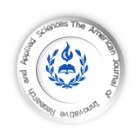
GENERAL INFORMATION

| ISSN: 2429-5396 (e) | www.american-jiras.com | |
| Web Site Form: v 0.1.05 | JF 22 Cours, Wellington le Clairval, Lillebonne | France |
| Web Site Form: v 0.1.05 | JF 22 Cours, Wellington le Clairval, Lillebonne | France |

| HOME | ABOUT US | ARCHIVE | AIMS AND SCOP | AUTHORS | REVIEW | SUMIBMIT MANUSCRIPT | EDITORIAL BOARED | PUBLICATION FEE |
| | ARTICLE | Am. J. innov. res. appl. sci. Volume 11, Issue 6, Pages 194-199 (December 2020) |
| Research Article 1 |

|
| HOME || ABOUT US || ARCHIVES || AIMS AND SCOP || AUTHORS || REVIEW|| SUBMIT MANUSCRIPT || EDITORIAL BOARD || CONTACT US |

| DECEMBER | VOLUME 11 | N° 6 | 2020 |

| Info-AJIRAS-® Journal ISSN 2429-5396 (Online) / Reference CIF/15/0289M |
American Journal of Innovative Research & Applied Sciences
Authors Contact
*Correspondant author and authors Copyright © 2020:
| Berrada Sanae 1.2.3* | Benjelloun Touimi Ghita 4 | Bennani Laila 1 | Squali Houssaini Fatma Zahra3 |Chrigui Mohammed 2 | Alami Abdellatif 2 | and | Sqalli Houssaini Tarik 5 |
Affiliation.
1. Departement of Fundamental Sciences | The Superior Institute of Nursing Professions and Health Technology of Fez (ISPITS), Fez, Morocco
2. Regional Diagnostic Laboratory Epidemiological and Environmental Health | Regional Health Directorate | Fez, Morocco |
3. Sidi Mohammed ben Abdellah University, Faculty of Sciences Dhar ElMahraz | LANENC Laboratory | Fez, Morocco |
4. Departement of Fundamental Sciences, Laboratory of Human Pathology Biomedecine and environnement | Faculty of Medicine and Pharmacy of Fez (FMPF) | Sidi Mohammed Ben Abdellah University (USMBA) | Fez, Morocco |
5. Nephrology Department | Hassan II University Hospital | Fez | Morocco |
This article is made freely available as part of this journal's Open Access: ID | Berrada–Ref21-ajira021120 |
*Correspondant author and authors Copyright © 2020:
| Berrada Sanae 1.2.3* | Benjelloun Touimi Ghita 4 | Bennani Laila 1 | Squali Houssaini Fatma Zahra3 |Chrigui Mohammed 2 | Alami Abdellatif 2 | and | Sqalli Houssaini Tarik 5 |
Affiliation.
1. Departement of Fundamental Sciences | The Superior Institute of Nursing Professions and Health Technology of Fez (ISPITS), Fez, Morocco
2. Regional Diagnostic Laboratory Epidemiological and Environmental Health | Regional Health Directorate | Fez, Morocco |
3. Sidi Mohammed ben Abdellah University, Faculty of Sciences Dhar ElMahraz | LANENC Laboratory | Fez, Morocco |
4. Departement of Fundamental Sciences, Laboratory of Human Pathology Biomedecine and environnement | Faculty of Medicine and Pharmacy of Fez (FMPF) | Sidi Mohammed Ben Abdellah University (USMBA) | Fez, Morocco |
5. Nephrology Department | Hassan II University Hospital | Fez | Morocco |
This article is made freely available as part of this journal's Open Access: ID | Berrada–Ref21-ajira021120 |
ABSTRACT
Context: The hospital environment is a microbial reservoir capable of contaminating people hospitalized which can cause nosocomial infections. Controlling one's infectious risk is an important element to overcome this major public health problem, especially in units where patients are more susceptible to nosocomial germs. Due to their immunodeficiency, circumstances of exposure to blood, infections in patients treated with dialysis are 100 times more common than in the general population. Objective: The aim of this study was to assess the percentage of contamination air’s patient treatment room, identify isolated germs and determinate their antibiotic susceptibility by the disk diffusion test. Method: We conducted microbiological monitoring of the air patient’s treatment room in the Al Ghassani Hospital’s Hemodialysis Center from March 2015 to June 2015. Result: The results of this control varied from 12 to 52 CFU / m3 and were all in accordance with standard NF S 90-351. The isolated germs revealed the absence of molds and the presence only of bacteria. The most frequent strains were Gram-positive bacteria, included various microorganisms such as Staphylococcus negative coagulase, Bacillus sp and Gram-negative bacilli non-fermentative positive oxidase. Concerning the antibiotic sensitivity, we noted differences depending on the type of bacteria and the antibiotic tested. All isolates showed significant resistance to at least three antibiotics. All strains remain sensitive to Imipenem. Conclusion: Our microbiological monitoring environment study testifies a bacterial contamination and the presence of different nosocomial bacteria in the air. It also confirmed the protuberant role of hospital environment in the spread of nosocomial pathogens. Indeed, bacterial strains mainly belonging to positive Gram were isolated. Among bacterial strains isolated, Staphylococcus negative coagulase was the most prevalent species (66.67%), followed by Bacillus sp and Gram-negative bacilli non-fermentative positive oxidase. All isolates were resistant to at least three antibiotics. The cross-transmission of these bacteria to hemodialysis patients may lead to severe nosocomial infections. In order to avoid nosocomial infections that may result, it is required to support the surveillance system applied in the studied center, support standard precautions’ agreement, in particular hand hygiene, as well as contact precautions. It would also be essential to strengthen staff training in hospital hygiene, to elaborate and optimize the environment’s disinfection protocol.
Keywords: Nosocomial infections, Hemodialysis center, Multi-drug resistance, Hospital environment, air.
Context: The hospital environment is a microbial reservoir capable of contaminating people hospitalized which can cause nosocomial infections. Controlling one's infectious risk is an important element to overcome this major public health problem, especially in units where patients are more susceptible to nosocomial germs. Due to their immunodeficiency, circumstances of exposure to blood, infections in patients treated with dialysis are 100 times more common than in the general population. Objective: The aim of this study was to assess the percentage of contamination air’s patient treatment room, identify isolated germs and determinate their antibiotic susceptibility by the disk diffusion test. Method: We conducted microbiological monitoring of the air patient’s treatment room in the Al Ghassani Hospital’s Hemodialysis Center from March 2015 to June 2015. Result: The results of this control varied from 12 to 52 CFU / m3 and were all in accordance with standard NF S 90-351. The isolated germs revealed the absence of molds and the presence only of bacteria. The most frequent strains were Gram-positive bacteria, included various microorganisms such as Staphylococcus negative coagulase, Bacillus sp and Gram-negative bacilli non-fermentative positive oxidase. Concerning the antibiotic sensitivity, we noted differences depending on the type of bacteria and the antibiotic tested. All isolates showed significant resistance to at least three antibiotics. All strains remain sensitive to Imipenem. Conclusion: Our microbiological monitoring environment study testifies a bacterial contamination and the presence of different nosocomial bacteria in the air. It also confirmed the protuberant role of hospital environment in the spread of nosocomial pathogens. Indeed, bacterial strains mainly belonging to positive Gram were isolated. Among bacterial strains isolated, Staphylococcus negative coagulase was the most prevalent species (66.67%), followed by Bacillus sp and Gram-negative bacilli non-fermentative positive oxidase. All isolates were resistant to at least three antibiotics. The cross-transmission of these bacteria to hemodialysis patients may lead to severe nosocomial infections. In order to avoid nosocomial infections that may result, it is required to support the surveillance system applied in the studied center, support standard precautions’ agreement, in particular hand hygiene, as well as contact precautions. It would also be essential to strengthen staff training in hospital hygiene, to elaborate and optimize the environment’s disinfection protocol.
Keywords: Nosocomial infections, Hemodialysis center, Multi-drug resistance, Hospital environment, air.
*Corresponding author Author & Copyright Author © 2020:| Berrada Sanae *|. All Rights Reserved. All articles published in American Journal of Innovative Research and Applied Sciences are the property of Atlantic Center Research Sciences, and
is protected by copyright laws CC-BY. See:http://creativecommons.org/licenses/by-nc/4.0/.

|
American Journal of innovative
Research & Applied Sciences
Research & Applied Sciences
ISSN 2429-5396 (Online)
OCLC Number: 920041286
OCLC Number: 920041286
IDENTIFICATION AND RESISTANCE TO ANTIBIOTICS OF BACTERIA ISOLATED FROM THE ENVIRONMENT OF A HOSPITAL SERVICE IN NORTHERN MOROCCO
| Berrada Sanae 1.2.3* | Benjelloun Touimi Ghita 4 | Bennani Laila 1 | Squali Houssaini Fatma Zahra3 |Chrigui Mohammed 2 | Alami Abdellatif 2 | and | Sqalli Houssaini Tarik 5 |. Am. J. innov. res. appl. sci. 2020; 11(6):194-199.
| PDF FULL TEXT | | XML FILE | | XML FILE | | Received | December 02, 2020 | | Accepted | December 18, 2020 | | Published | December 31, 2020 |
| Berrada Sanae 1.2.3* | Benjelloun Touimi Ghita 4 | Bennani Laila 1 | Squali Houssaini Fatma Zahra3 |Chrigui Mohammed 2 | Alami Abdellatif 2 | and | Sqalli Houssaini Tarik 5 |. Am. J. innov. res. appl. sci. 2020; 11(6):194-199.
| PDF FULL TEXT | | XML FILE | | XML FILE | | Received | December 02, 2020 | | Accepted | December 18, 2020 | | Published | December 31, 2020 |